A Novel Construction Technology for Self-Anchored Suspension Bridge Considering Safety and Sustainability Performance
Abstract
:1. Introduction
2. Sustainability Assessment on Construction Technologies for Self-Anchored Suspension Bridge
2.1. Environmental Impact and Traffic Disruption Caused by Traditional Construction Technologies
2.2. Novel TPA Technology to Improve Construction Sustainability
2.3. Primary Sustainability Performance of Construction Technologies
2.4. Assessment Method and Index Considering Construction Sustainability
3. Design-Oriented Analytical Approach for Novel Antithrust System
3.1. Novel Girder–Pylon Antithrust System
3.2. Failure Modes and Mechanism of Force Transmission
3.3. Global Design Formulas
3.4. Design-Oriented Two-Phase Analytical Framework
4. Design and Engineering Implementation
4.1. Determination of Unfavorable Construction State
4.2. Phase I: Global Design
4.3. Phase II: Parametric Study
4.3.1. FEA
4.3.2. Parametric Analysis
Effects of Penetrating Rebar Diameter and Perforated Rib Hole Spacing
Effects of the Diameter and Length of U-Shaped Anchor Rebar
Effects of the Number of Grille Plates
4.3.3. Performance Improvement
PBL Shear Connectors
U-Shaped Anchor Rebar
Grille Frame
Concrete Anchorage Zone
4.4. Field Test and Verification
5. Result Discussion on Construction Sustainability
6. Conclusions
Author Contributions
Funding
Conflicts of Interest
References
- Penadés-Plà, V.; Martí, J.V.; García-Segura, T.; Yepes, V. Life-Cycle Assessment: A Comparison between Two Optimal Post-Tensioned Concrete Box-Girder Road Bridges. Sustainability 2017, 9, 1864. [Google Scholar] [CrossRef] [Green Version]
- Frangopol, D.M.; Dong, Y.; Sabatino, S. Bridge life-cycle performance and cost: Analysis, prediction, optimisation and decision-making. Struct. Infrastruct. Eng. 2017, 13, 1239–1257. [Google Scholar] [CrossRef]
- Kripka, M.; Yepes, V.; Milani, C. Selection of Sustainable Short-Span Bridge Design in Brazil. Sustainability 2019, 11, 1307. [Google Scholar] [CrossRef] [Green Version]
- Khan, M.A. Accelerated Bridge Construction: Best Practices and Techniques; Butterworth-Heinemann: Oxford, UK, 2014. [Google Scholar]
- Dong, Y. Performance assessment and design of ultra-high performance concrete (UHPC) structures incorporating life-cycle cost and environmental impacts. Constr. Build. Mater. 2018, 167, 414–425. [Google Scholar] [CrossRef]
- Gilchrist, A.; Allouche, E.N. Quantification of social costs associated with construction projects: State-of-the-art review. Tunn. Undergr. Space Technol. 2005, 20, 89–104. [Google Scholar] [CrossRef]
- Grierson, D. Towards a sustainable built environment. CIC Start Online Innov. Rev. 2009, 1, 70–77. [Google Scholar]
- Wang, Z.; Jin, W.-L.; Dong, Y.; Frangopol, D.M. Hierarchical life-cycle design of reinforced concrete structures incorporating durability, economic efficiency and green objectives. Eng. Struct. 2018, 157, 119–131. [Google Scholar] [CrossRef]
- Goh, C.S.; Chong, H.-Y.; Jack, L.; Faris, A.F.M. Revisiting triple bottom line within the context of sustainable construction: A systematic review. J. Clean. Prod. 2020, 252, 119884. [Google Scholar] [CrossRef]
- Anwar, G.A.; Dong, Y.; Zhai, C. Performance-based probabilistic framework for seismic risk, resilience, and sustainability assessment of reinforced concrete structures. Adv. Struct. Eng. 2019. [Google Scholar] [CrossRef]
- Gou, H.; Wang, W.; Shi, X.; Pu, Q.; Kang, R. Behavior of steel-concrete composite cable anchorage system. Steel Compos. Struct. 2018, 26, 115–123. [Google Scholar]
- Wang, X.; Frangopol, D.M.; Dong, Y.; Lei, X.; Zhang, Y. Novel Technique for Configuration Transformation of 3D Curved Cables of Suspension Bridges: Application to the Dongtiao River Bridge. J. Perform. Constr. Facil. 2018, 32, 04018045. [Google Scholar] [CrossRef]
- Gil, H.; Choi, Y. Cable Erection Test at Splay Band for Spatial Suspension Bridge. J. Bridg. Eng. 2002, 7, 300–307. [Google Scholar] [CrossRef]
- Sun, J.; Manzanarez, R.; Nader, M. Suspension Cable Design of the New San Francisco–Oakland Bay Bridge. J. Bridg. Eng. 2004, 9, 101–106. [Google Scholar] [CrossRef]
- Nie, J.; Zhou, M.; Wang, Y.-H.; Fan, J.-S.; Tao, M.-X. Cable Anchorage System Modeling Methods for Self-Anchored Suspension Bridges with Steel Box Girders. J. Bridg. Eng. 2014, 19, 172–185. [Google Scholar] [CrossRef]
- Nader, M. Accelerated Bridge Construction of the New Samuel De Champlain Bridge. J. Bridg. Eng. 2020, 25, 05019015. [Google Scholar] [CrossRef]
- Siwowski, T.; Wysocki, A. Horizontal Rotation via Floatation as an Accelerated Bridge Construction for Long-Span Footbridge Erection: Case Study. J. Bridg. Eng. 2015, 20, 05014014. [Google Scholar] [CrossRef]
- Sun, J.F.; Fang, J.H.; Tan, Q.Q.; F.Li, L. Introduction of novel construction method for superstructure of self-anchored suspension bridge. Prestress Technol. 2004, 25–29. [Google Scholar]
- Ultimate capacity of narrow type steel box section for railway self-anchored suspension bridge under bias compression. In Ultimate Capacity of Narrow Type Steel Box Section for Railway Self-Anchored Suspension Bridge under Bias Compression; Hong Kong Institute of Steel Construction: Hong Kong, China, 2019; Volume 15, pp. 173–184.
- Verkehr, B.F.; Wirtschaft, M.F.; Rheinland, L. Denkschrift zur Verkehrsübergabe der Wiederhergestellten Autobahnbrücke über den Rhein in Rodenkirchen bei Köln am 9.Dezember 1954; Springer Science and Business Media LLC: Berlin, Germany, 1954. [Google Scholar]
- Van Goolen, D. Self-Anchored Suspension Bridges; Delft University of Technology: Delft, The Netherlands, 2006. [Google Scholar]
- Navarro, I.J.; Yepes, V.; Martí, J.V. Life Cycle Cost Assessment of Preventive Strategies Applied to Prestressed Concrete Bridges Exposed to Chlorides. Sustainability 2018, 10, 845. [Google Scholar] [CrossRef] [Green Version]
- Penadés-Plà, V.; García-Segura, T.; Martí, J.V.; Yepes, V. An Optimization-LCA of a Prestressed Concrete Precast Bridge. Sustainability 2018, 10, 685. [Google Scholar] [CrossRef] [Green Version]
- Chang, Y.; Yang, Y.; Dong, S. Comprehensive Sustainability Evaluation of High-Speed Railway (HSR) Construction Projects Based on Unascertained Measure and Analytic Hierarchy Process. Sustainability 2018, 10, 408. [Google Scholar] [CrossRef] [Green Version]
- Seo, S.-Y.; Lee, B.; Won, J. Comparative Analysis of Economic Impacts of Sustainable Vertical Extension Methods for Existing Underground Spaces. Sustainability 2020, 12, 975. [Google Scholar] [CrossRef] [Green Version]
- Nie, J.; Tao, M.; Fan, J. Research on Cable Anchorage Systems for Self-Anchored Suspension Bridges with Steel Box Girders. J. Bridg. Eng. 2011, 16, 633–643. [Google Scholar] [CrossRef]
- Deng, W.; Xiong, Y.; Liu, D.; Zhang, J. Static and fatigue behavior of shear connectors for a steel-concrete composite girder. J. Constr. Steel Res. 2019, 159, 134–146. [Google Scholar] [CrossRef]
- Leroy, A.L.; Peter, G. Mechanics of bond and slip of deformed bars in concrete. J. Proc. 1967, 64, 711–721. [Google Scholar]
- Zhao, C.; Li, Z.; Deng, K.; Wang, W. Experimental investigation on the bearing mechanism of Perfobond rib shear connectors. Eng. Struct. 2018, 159, 172–184. [Google Scholar] [CrossRef]
- Huang, Q. Design Principle of Bridge Steel-Concrete Composite Structure; China Communications Press Co., Ltd.: Beijing, China, 2017. [Google Scholar]
- MOT. GB 50917-2013. Code for Design of Steel and Concrete Composite Bridges; CABP: Beijing, China, 2013. [Google Scholar]
- Lou, X.; Wu, H.; Cui, B. Designing and Construction of Suspension Bridge Main Cable Anchor Transferring Load Distributively; China Communications Press Co., Ltd.: Beijing, China, 2012. [Google Scholar]
- MOT. JTG D62-2004 Specifications for Design of Highway Reinforced Concreteand Prestressed Concrete Bridges and Culverts; CCP: Beijing, China, 2004. [Google Scholar]
- MOT. GB 50017-2017 Standard for Design of Steel Structures; CABP: Beijing, China, 2017. [Google Scholar]
- MOT. JTG/T F50-2011 Technical Specification for Construction of Highway Bridge and Culverts; CCP: Beijing, China, 2011. [Google Scholar]
- Ahn, J.-H.; Lee, C.-G.; Won, J.-H.; Kim, S.-H. Shear resistance of the perfobond-rib shear connector depending on concrete strength and rib arrangement. J. Constr. Steel Res. 2010, 66, 1295–1307. [Google Scholar] [CrossRef]
- Wang, S.; He, J.; Liu, Y.; Li, C.; Xin, H. Shear capacity of a novel joint between corrugated steel web and concrete lower slab. Constr. Build. Mater. 2018, 163, 360–375. [Google Scholar] [CrossRef] [Green Version]
- Gu, J.-C.; Liu, D.; Deng, W.-Q.; Zhang, J. Experimental study on the shear resistance of a comb-type perfobond rib shear connector. J. Constr. Steel Res. 2019, 158, 279–289. [Google Scholar] [CrossRef]
- Li, Z.; Zhao, C.; Shu, Y.; Deng, K.; Cui, B.; Su, Y. Full-scale test and simulation of a PBL anchorage system for suspension bridges. Struct. Infrastruct. Eng. 2019, 16, 452–464. [Google Scholar] [CrossRef]
- Willam, K.J. Constitutive model for the triaxial behaviour of concrete. Proc. Intl. Assoc. Bridge Structl. Eng. 1975, 19, 1–30. [Google Scholar]
- He, J.; Liu, Y.; Lin, Z.; Chen, A.; Yoda, T. Shear behavior of partially encased composite I-girder with corrugated steel web: Numerical study. J. Constr. Steel Res. 2012, 79, 166–182. [Google Scholar] [CrossRef]
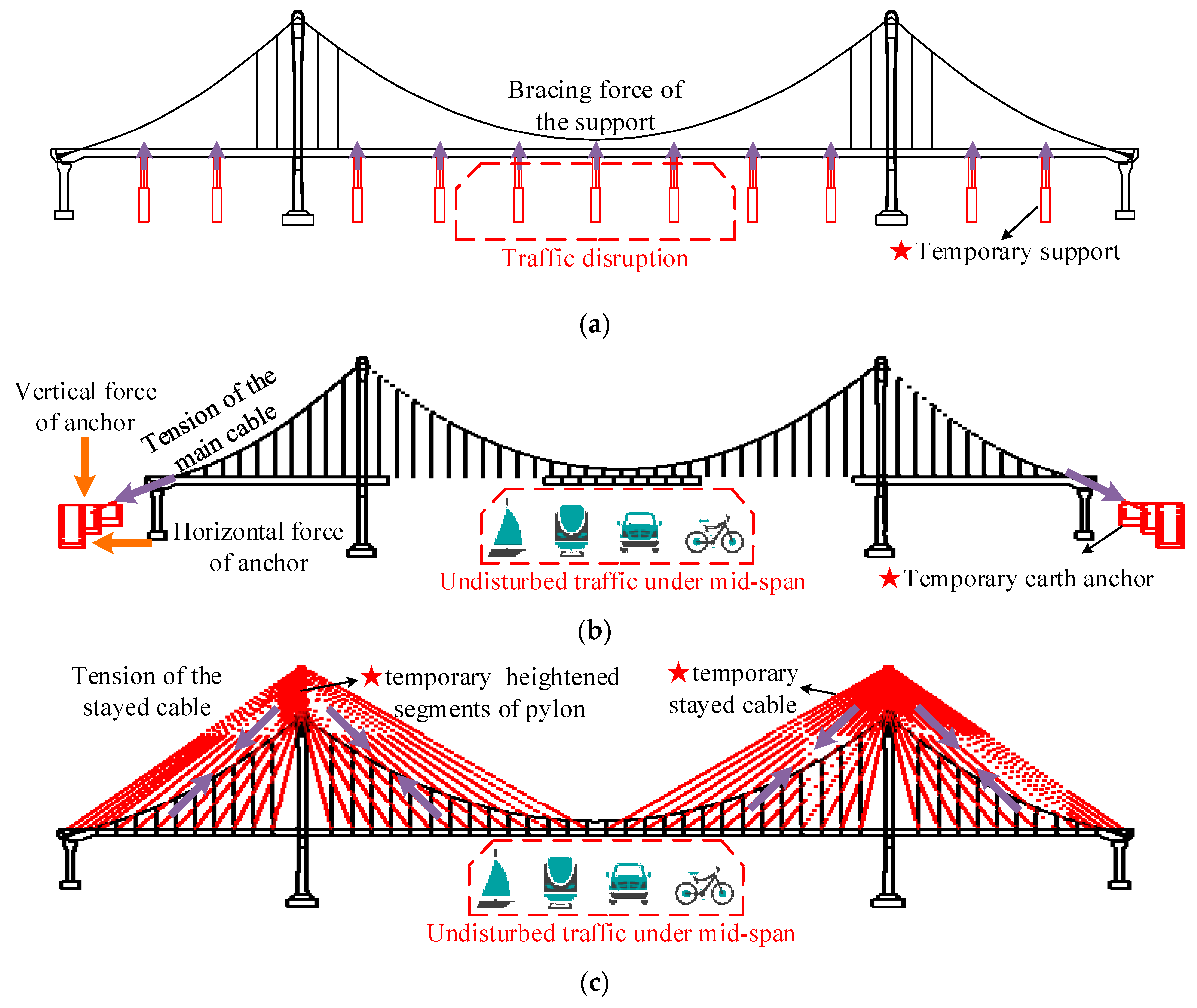
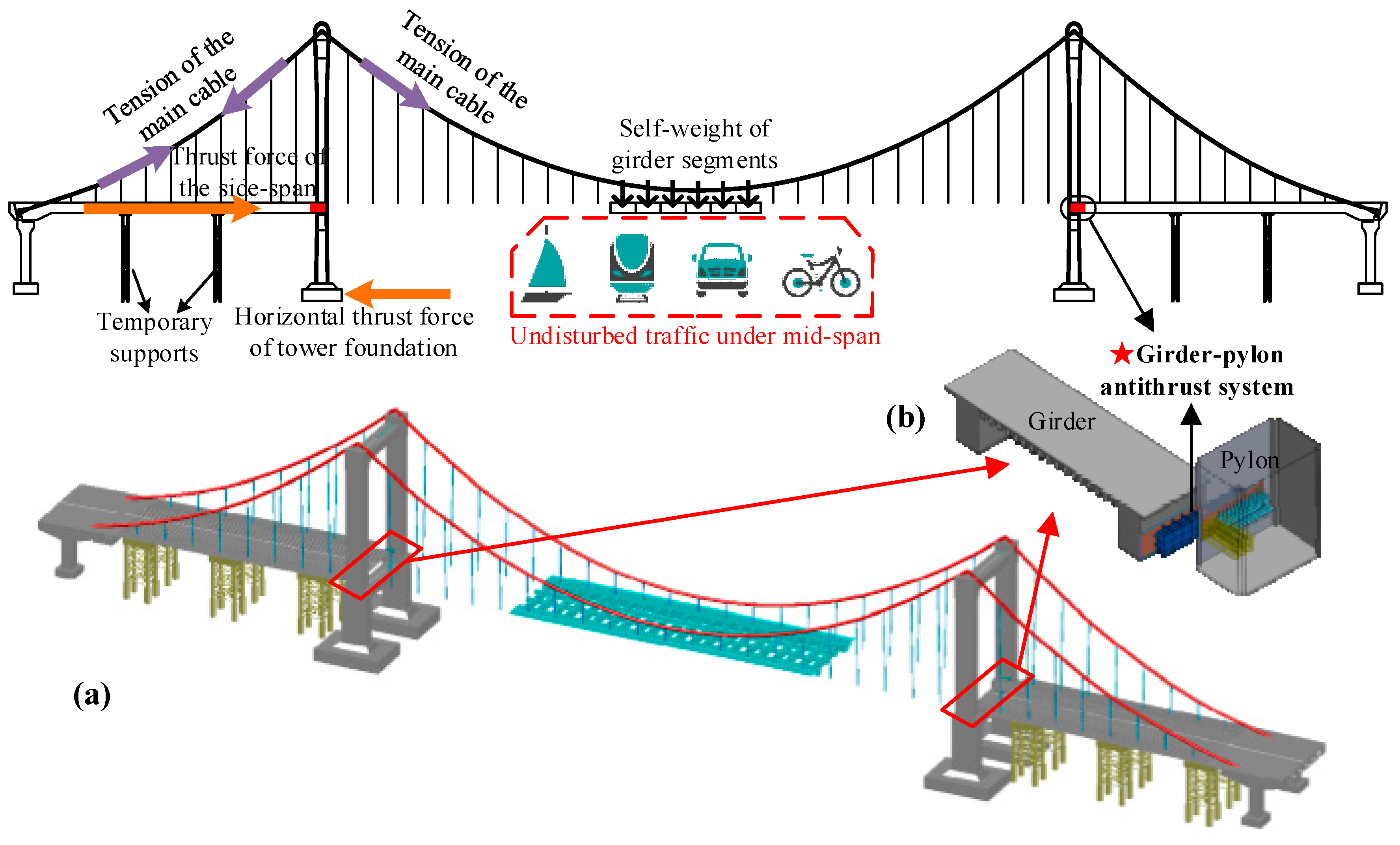



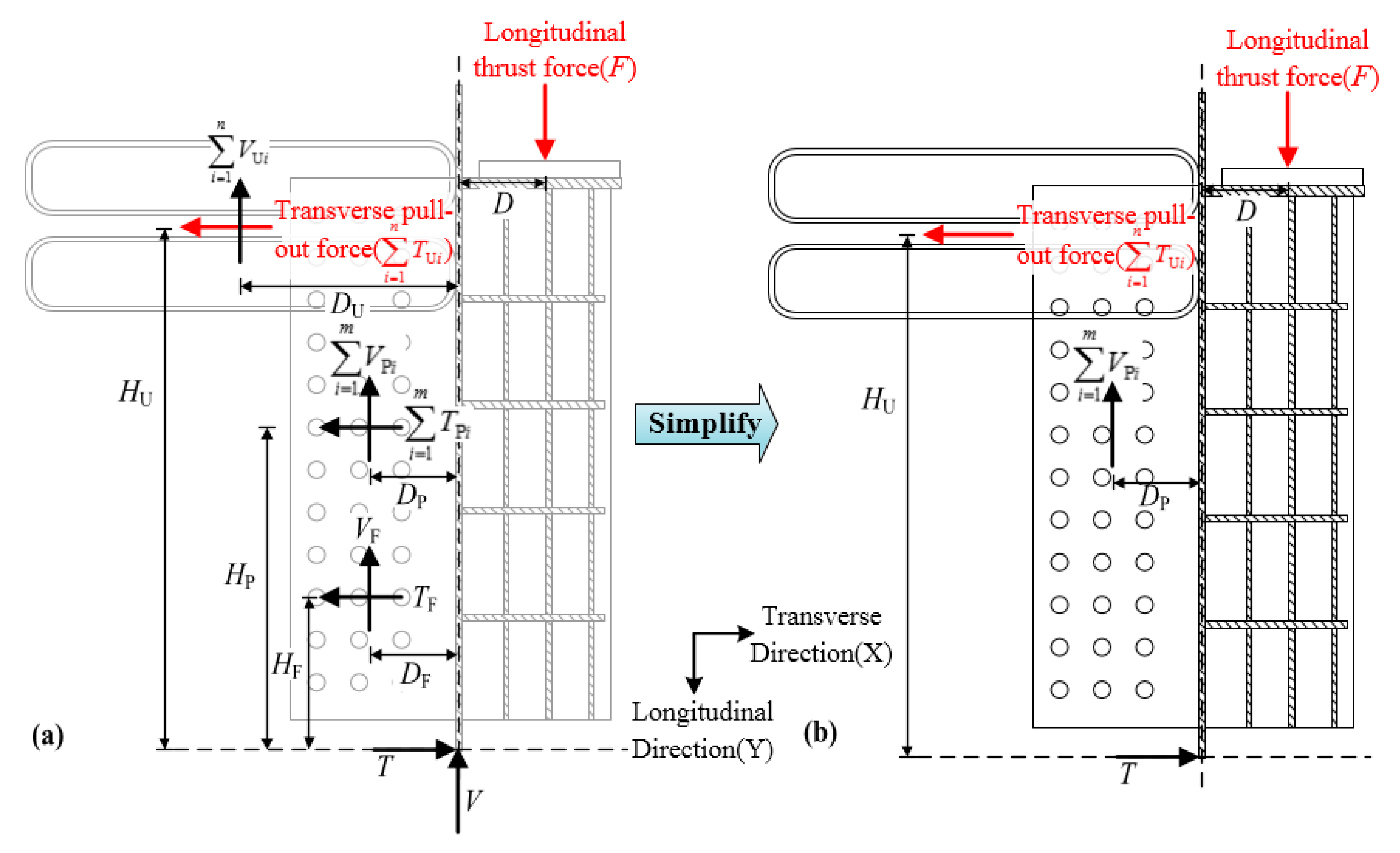









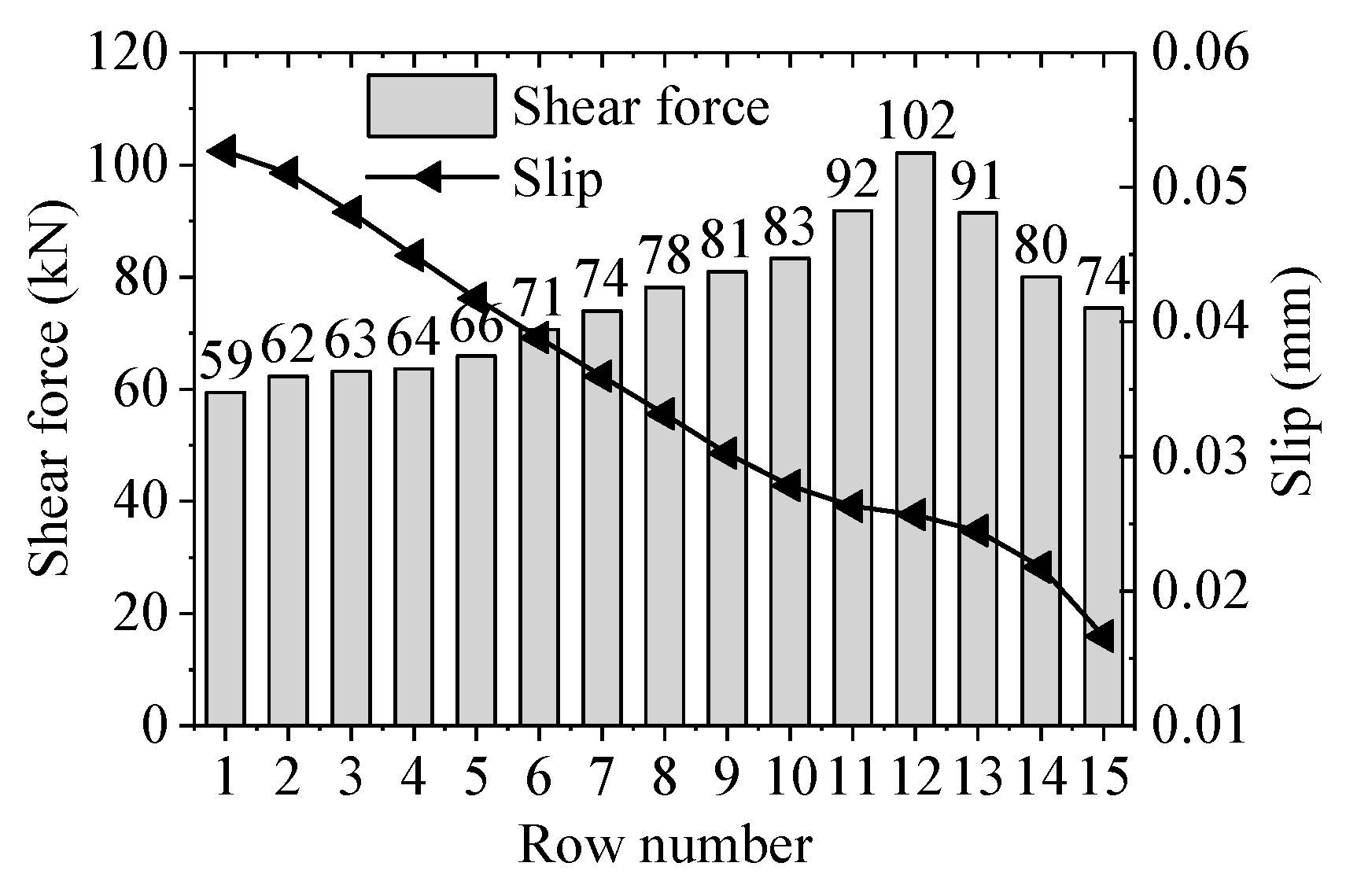

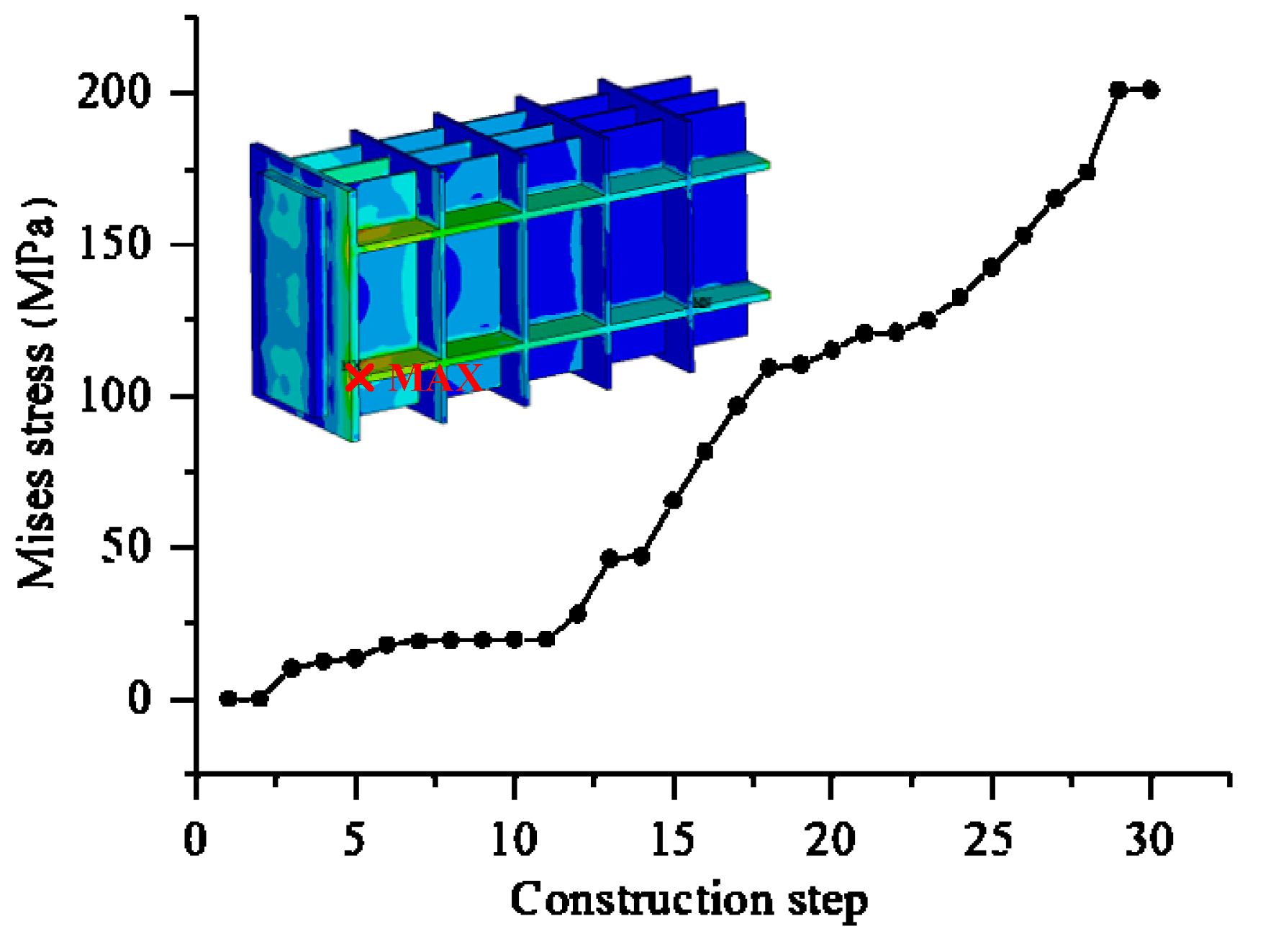
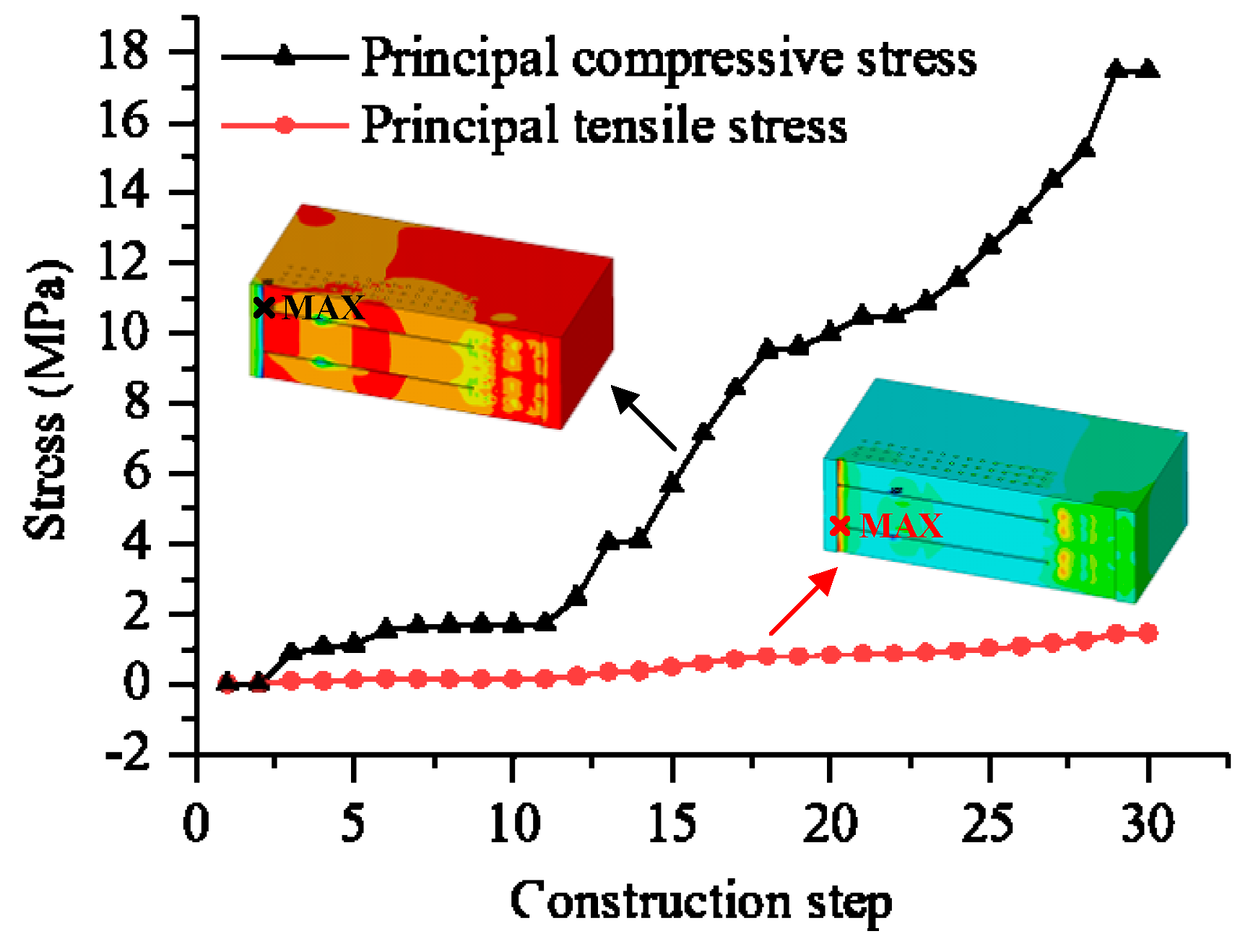

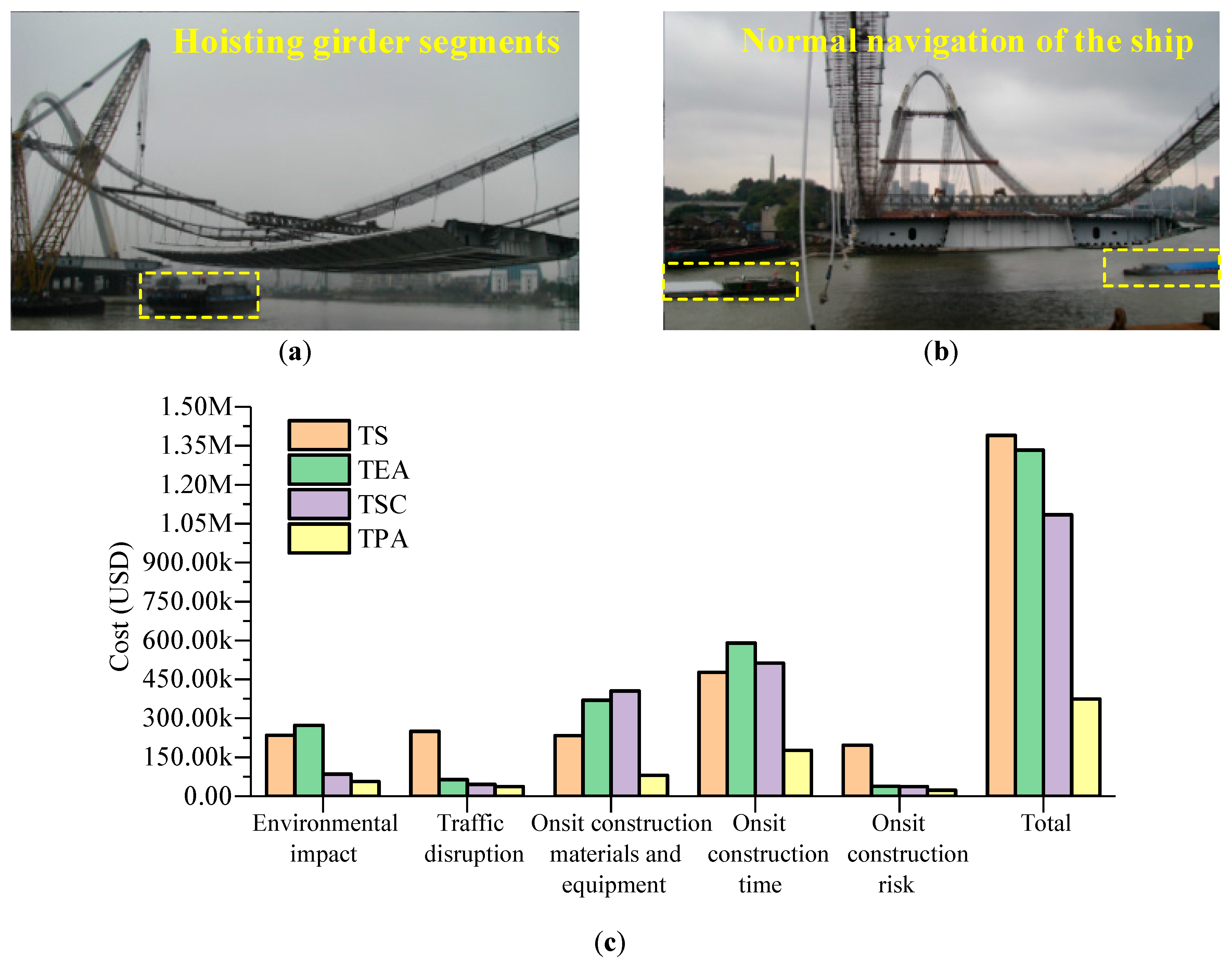
| Technology | Temporary Supports [13,26] | Temporary Earth-Anchor [18] | Temporary Stayed-Cables [19,20] | The Proposed Temporary Pylon-Anchor | |
|---|---|---|---|---|---|
| Performance | |||||
| Environmental impact | Serious: environmental damage caused by temporary supports’ foundation | Serious: environmental damage caused by temporary earth-anchorage | Almost none | Almost none | |
| Traffic disruption | Serious: traffic under the bridge is blocked by temporary supports | Almost none | Almost none | Almost none | |
| Onsite construction materials and equipment | High: lots of temporary supports | High: expensive temporary earth-anchorage | High: lots of temporary stayed-cables, heightened segments of pylon | Low: cheap girder–pylon antithrust system | |
| Onsite construction time | Long: lots of time-consuming for erection and removal of supports | Long: lots of time-consuming for erection and removal of earth-anchorage | Long: lots of time-consuming for erection and removal of stay-cables and heightened segments of pylon | Short: Fast erection and removal of girder–pylon antithrust system | |
| Onsite construction risk | High: temporary supports subjected to flood and collision of vehicles | Low | Low | Low | |
| Material | Grade | Compressive Strength/MPa | Tensile Strength/MPa | Yield Strength/MPa | Young’s Modulus/GPa |
|---|---|---|---|---|---|
| Structural steel | Q345C | 270 | 270 | 345 | 210 |
| Rebar | HRB400 | 330 | 330 | 400 | 200 |
| Concrete | C50 | 22.4 | 1.83 | - | 34.5 |
| Specimens | PS (mm) | PD (mm) | UL (mm) | UD (mm) | NL | NT |
|---|---|---|---|---|---|---|
| T1 | 200 | 25 | 1800 | 25 | 2 | 5 |
| T1-PD-20 | 200 | 20 | 1800 | 25 | 2 | 5 |
| T1-PD-22 | 200 | 22 | 1800 | 25 | 2 | 5 |
| T1-PD-28 | 200 | 28 | 1800 | 25 | 2 | 5 |
| T1-PD-32 | 200 | 32 | 1800 | 25 | 2 | 5 |
| T1-PS-100 | 100 | 25 | 1800 | 25 | 2 | 5 |
| T1-PS-150 | 150 | 25 | 1800 | 25 | 2 | 5 |
| T1-PS-250 | 250 | 25 | 1800 | 25 | 2 | 5 |
| T1-PS-300 | 300 | 25 | 1800 | 25 | 2 | 5 |
| T1-UD-20 | 200 | 25 | 1800 | 20 | 2 | 5 |
| T1-UD-22 | 200 | 25 | 1800 | 22 | 2 | 5 |
| T1-UD-28 | 200 | 25 | 1800 | 28 | 2 | 5 |
| T1-UD-32 | 200 | 25 | 1800 | 32 | 2 | 5 |
| T1-UL-1600 | 200 | 25 | 1600 | 25 | 2 | 5 |
| T1-UL-2000 | 200 | 25 | 2000 | 25 | 2 | 5 |
| T1-UL-2200 | 200 | 25 | 2200 | 25 | 2 | 5 |
| T1-UL-2400 | 200 | 25 | 2400 | 25 | 2 | 5 |
| T1-NL(3)-NT(5) | 200 | 25 | 1800 | 25 | 3 | 5 |
| T1-NL(4)-NT(5) | 200 | 25 | 1800 | 25 | 4 | 5 |
| T1-NL(5)-NT(5) | 200 | 25 | 1800 | 25 | 5 | 5 |
| T1-NL(2)-NT(4) | 200 | 25 | 1800 | 25 | 2 | 4 |
| T1-NL(2)-NT(6) | 200 | 25 | 1800 | 25 | 2 | 6 |
| T1-NL(2)-NT(7) | 200 | 25 | 1800 | 25 | 2 | 7 |
| Division of Construction | Unit | Quantity | Unit price (USD) | Cost (USD) | Sum (USD) | ||
|---|---|---|---|---|---|---|---|
| Environmental impact (C1) | 56,838 | 56,838 | |||||
| Traffic disruption (C2) | Hour | 76 | 412 | 31,312 | 31,312 | ||
| Onsite construction materials and equipment (C3) | GPAS Materials | Steel | ton | 7.87 | 584 | 4596 | 80,400 |
| Reinforcing bars | ton | 0.8 | 541 | 433 | |||
| Equipment | Arc welder | Set | 2 | 5870 | 11,740 | ||
| Plasma cutting machine | Set | 2 | 21,428 | 42,856 | |||
| Other | Set | 15 | 1385 | 20,775 | |||
| Onsite construction time (C4) | Day | 21 | 8405 | 176,505 | 176,505 | ||
| Onsite construction risk (C5) TPGA | 22,600 | 22,600 | |||||
| Total (C) | 367,655 | ||||||
© 2020 by the authors. Licensee MDPI, Basel, Switzerland. This article is an open access article distributed under the terms and conditions of the Creative Commons Attribution (CC BY) license (http://creativecommons.org/licenses/by/4.0/).
Share and Cite
Wang, X.; Wang, X.; Dong, Y.; Wang, C. A Novel Construction Technology for Self-Anchored Suspension Bridge Considering Safety and Sustainability Performance. Sustainability 2020, 12, 2973. https://doi.org/10.3390/su12072973
Wang X, Wang X, Dong Y, Wang C. A Novel Construction Technology for Self-Anchored Suspension Bridge Considering Safety and Sustainability Performance. Sustainability. 2020; 12(7):2973. https://doi.org/10.3390/su12072973
Chicago/Turabian StyleWang, Xiaoming, Xudong Wang, You Dong, and Chengshu Wang. 2020. "A Novel Construction Technology for Self-Anchored Suspension Bridge Considering Safety and Sustainability Performance" Sustainability 12, no. 7: 2973. https://doi.org/10.3390/su12072973
APA StyleWang, X., Wang, X., Dong, Y., & Wang, C. (2020). A Novel Construction Technology for Self-Anchored Suspension Bridge Considering Safety and Sustainability Performance. Sustainability, 12(7), 2973. https://doi.org/10.3390/su12072973







